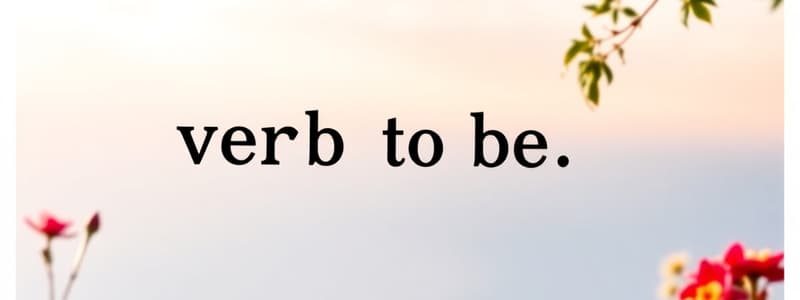Podcast
Questions and Answers
Which of the following is NOT a form of the verb 'to be' in the present tense?
Which of the following is NOT a form of the verb 'to be' in the present tense?
- were (correct)
- is
- am
- are
The verb 'to be' can function as a linking verb.
The verb 'to be' can function as a linking verb.
True (A)
Give an example of a sentence using the verb 'to be' to express existence.
Give an example of a sentence using the verb 'to be' to express existence.
There is a cat.
They _____ at the library yesterday.
They _____ at the library yesterday.
Match the tense with the correct 'to be' form.
Match the tense with the correct 'to be' form.
Which sentence correctly uses the future continuous tense of 'to be'?
Which sentence correctly uses the future continuous tense of 'to be'?
'To be' is only used with action verbs.
'To be' is only used with action verbs.
Provide the contraction for 'we are'.
Provide the contraction for 'we are'.
She _____ a teacher.
She _____ a teacher.
Select the sentence that contains the past perfect progressive form of 'to be':
Select the sentence that contains the past perfect progressive form of 'to be':
Flashcards
Verb 'to be'
Verb 'to be'
A linking verb connecting subjects to descriptors or identifiers.
Present tense forms
Present tense forms
Forms of 'to be' in present tense: am, are, is.
Past tense forms
Past tense forms
Forms of 'to be' in past tense: was, were.
Future tense forms
Future tense forms
Signup and view all the flashcards
Linking subject
Linking subject
Signup and view all the flashcards
Expressing existence
Expressing existence
Signup and view all the flashcards
State of being
State of being
Signup and view all the flashcards
Stative verbs
Stative verbs
Signup and view all the flashcards
Present continuous
Present continuous
Signup and view all the flashcards
Contractions of 'to be'
Contractions of 'to be'
Signup and view all the flashcards
Study Notes
Introduction
- The verb "to be" is a crucial verb in English grammar.
- It functions as a linking verb, connecting the subject of a sentence to a noun, pronoun, or adjective that describes or identifies it.
- Its forms vary across tenses and persons.
Forms of "to be"
- Present tense:
- I am
- you are
- he/she/it is
- we are
- you are (plural)
- they are
- Past tense:
- I was
- you were
- he/she/it was
- we were
- you were (plural)
- they were
- Future tense (using "will" or "shall"):
- I will/shall be
- you will be
- he/she/it will be
- we will/shall be
- you will be (plural)
- they will be
Uses of "to be"
- Linking subject to a descriptive or identifying element:
- Example: "The cat is black." (linking "cat" with the adjective "black")
- Example: "She is a doctor." (linking "she" with the noun "doctor")
- Expressing existence:
- Example: "There is a dog." (indicating the presence of a dog)
- Example: "They are at the park." (describing their location)
- Expressing state of being:
- Example: "I am happy." (describing a feeling)
- Example: "He is tired" (describing a condition)
- Stative Verbs: "to be" is often used with stative verbs and adjectives. Stative verbs describe states of being, not actions.
Tenses of "to be" in context
- Present continuous/Progressive: "I am studying." (indicates an action in progress)
- Past Continuous/Progressive: "I was studying." (indicates an action in progress at a specific time in the past)
- Future Continuous/Progressive: "I will be studying." (indicates an action in progress at a specific time in the future)
- Present Perfect: "I have been studying." (indicates an action that started in the past and continues to the present)
- Past Perfect: "I had been studying." (indicates an action that started in the past and continued up to another point in the past)
Contractions
- Common contractions include: I'm, you're, he's, she's, it's, we're, they're, and wasn't.
Importance in English Grammar
- Mastering "to be" is crucial for structuring basic and complex sentences in English.
Other Considerations
- Passive voice: "to be" is essential in passive voice constructions, e.g., "The car is driven by John."
- Identifying actions (adjectival use): "to be" is used to identify and describe nouns and pronouns when they describe or are described by other nouns or pronouns, and adjectives.
- "There is/are" construction: The use of "there is/are" and the singular/plural choice of "is" or "are" is often a source of confusion.
Studying That Suits You
Use AI to generate personalized quizzes and flashcards to suit your learning preferences.


